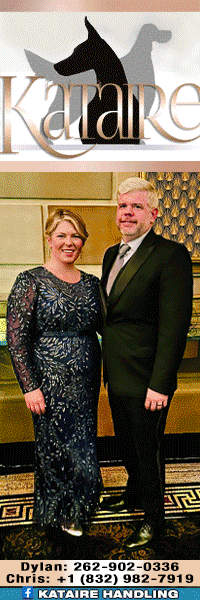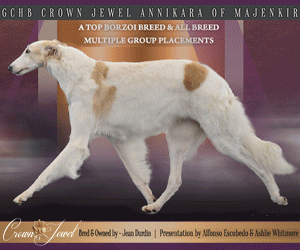Henrietta Proctor Donnell – Bringing Vaudeville Style to Dog Shows

By Amy Fernandez
As a rule, dog people are unconventional. Standing out among this colorful crowd isn’t easy. But Henrietta Proctor Donnell inherited her eccentricities along with her family fortune. Her father, F.F. Proctor, has gone down in history as the Dean of Vaudeville. Acrobat/juggler isn’t a career path typically associated with fabulous wealth. But Proctor rose to the top of entertainment industry in the late nineteenth century.
He met and married a fellow performer while touring music halls. In 1886 they settled down and purchased their first theater in Albany, N.Y. That led to a chain of 35 vaudeville theaters along the east coast. Proctor introduced the first vaudeville circuit to keep his theaters booked with the many acts he managed. His greatest innovation was the continuous performance. His theaters offered variety shows from noon to midnight. By the twentieth century, Proctor’s flourishing entertainment empire was perfectly positioned to capitalize on the emerging film industry.
Unfortunately, after more than 50 years in the business, his workaholic lifestyle caught up with him. He died of congestive heart failure in 1929. The enormous Proctor fortune ensured that his youngest daughter, Henrietta, had time and money to pursue her interests. And her overriding passion was dogs. This was another legacy from her dog-loving father who got her started by presenting her with four Mastiffs when she was just four years old. His pet name for her also inspired her kennel prefix, Etty Haven.
Henrietta started out showing English Toy Spaniels, but dabbled in many breeds including Borzoi, Whippets, Bedlingtons, Cockers, Bull Terriers, GSD, Miniature Schnauzers, Irish Setters, St. Bernards, Bostons, Schipperke, and Poodles. But she really pulled out the big guns to campaign Toy breeds. She maintained a kennel on a scale barely imaginable today. Etty Haven generally accommodated over 100 dogs of approximately 20 breeds. Their lavish care and attention was legendary. AKC Gazette editor Arthur Frederick Jones visited in 1935. His subsequent kennel profile emphasized the luxurious conditions, although he couldn’t conceal his amazement to see dogs lounging on antique chairs and priceless furniture repurposed for their comfort.
Many Etty Haven dogs divided their time between Henrietta’s Larchmont residence and her Central Valley summer estate. Known as Proctoria, it was the pinnacle of her family’s fabulous homes. Situated on 1142 acres, it featured five houses, manmade lakes, waterfalls, beaches, a golf course, and the Etty Haven kennel. Most of her larger breeds lived there full time. Her small dogs were trucked 35 miles back and forth as she changed residences. Transporting 50-60 dogs seems complicated, but it was routine business for someone accustomed to vaudeville road shows that traveled the country with large crews and truckloads of equipment.
Thanks to her vaudeville heritage she also understood the crucial connection between public recognition and success. Coast to coast promotion was second nature to her. Henrietta knew exactly how to get her show on the road when circuits and interstate travel began revising the dog game.
She was one of the most active exhibitors of the 1930s. Etty Haven routinely showed four or five representatives of 15-20 breeds from coast to coast. Her goal was getting her dogs into the ring, and fanciers avidly followed her frenetic show schedule. In June 1933, the Gazette Chihuahua breed column reported, “we can thank Henrietta Proctor Donnell for making a number of shows after the Garden. From there she went to Miami and then back north to D.C. She exhibited at all the Southern shows, carrying on through April at Winston Salem, Charlotte, Asheville, and Durham… backsliding club members can thank Mrs. Donnell for keeping the breed well represented at all eastern shows.”
But this demanding routine didn’t always go as planned, as noted in the January 1934 Gazette. “At Fort Worth Mrs. Donnell’s dogs had just arrived in a big open Curtis Palace trailer in intense heat and went into the ring the morning of their arrival. Unaccustomed to the heat and travel dust, after the cool October air of New York, the Donnell dogs were glad to be out of their traveling trailer pens. They rolled and wallowed about and were taken in the ring covered in dust and stubble.”
Back then, Longcoat Chihuahuas got a cool reception from the judges. She went to battle, said the July 1934 Gazette column, “It has been evident that judges discriminate against the Longhaired variety and they are not sufficiently familiar with it. In order to acquaint judges and others more fully with the breed and the longhaired type in particular it was voted to publish an official standard. A further step forward to making it popular was taken when Mrs. Donnell, our president, announced that she will offer a cup to the club for the top winning Long-coated Chihuahua.”
Promotion was second nature to Henrietta, but like her father she preferred to think big. Breed clubs rejoiced when she joined their ranks because it inevitably included generous financial support. Among others, the Brussels Griffon, Pomeranian, Schipperke, and Boston Terrier clubs benefited from her interest. But she really pulled out the stops for her favorites. She served as president of the Chihuahua Club of America from 1930-38. In May 1932, the AKC Gazette columnist happily reported, “The burden of the expense for running the club which was carried primarily by Mrs. Ida Garrett during the many years she was secretary has been lifted by our president who is the first person to make a generous contribution in the three figures mark.”
She was equally involved in Miniature Pincher’s fortunes, helping to found the national club and serving as its first president. The breed also benefited from her valuable German imports like the 1930 sieger Konig Heinzelmennchen. His elegant tapered head, beautiful eye shape, sturdy legs, and scissors bite redefined Min Pin quality. In January 1933, he became the breed’s first group winner. Within months, she imported several others and campaigned them relentlessly. In January 1934, the Gazette breed columnist remarked, “Our president, Mrs. H. Proctor Donnell, has shown her Ch. Konig and others at several shows south of New York where the breed has not been presented at all in prior years.” Konig won six groups that year, but his extensive show campaign had a bigger impact by making him accessible to fanciers throughout the country.
Her greatest legacy was the Progressive Dog Club. She was a founder and first president of America oldest Toy group club. Henrietta was dedicated to revising prevailing negative perceptions of Toy breeds as pets rather that serious show ring contenders. She became an internationally-acknowledged Toy breed authority and a popular judge. However, she regularly refused many assignments because Etty Haven was often the sole kennel that kept some breeds before the public.
For instance, her Affenpinscher import, German Ch. Niki v. Zwergteufel, won BOB at Westminster from 1938-1943. Subsequently his kennelmate, Ger. Ch. Everl v. Franziskusklause, took over for the next four years. Despite her love for the breed, there is no record of Etty Haven Affenpinscher breeding. That was never her primary interest. She couldn’t imagine accepting money for her dogs and emphasized that she never sold them. Her satisfaction came from using her resources to help her favorite breeds. But she was a dedicated dog lover long before her involvement in the sport. She maintained a private shelter at Etty Haven kennel where she cared for hundreds of her so-called orphans.
For more than 30 years Henrietta participated in every facet of the dog world. Her efforts translated into nice wins but she could have easily achieved spectacular records by focusing her resources on competitive breeds. Perhaps her unconventional background didn’t point her towards mainstream success. But her offbeat taste for obscure breeds contributed substantially to their ultimate success.
Short URL: http://caninechronicle.com/?p=39492
Comments are closed











